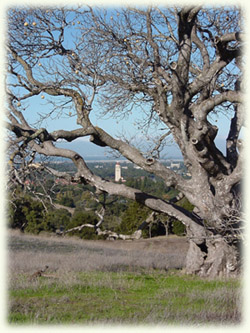|
 News News
 Subscribe to Our Newsletter Subscribe to Our Newsletter
 Sign up for Email Updates
Sign up for Email Updates
 CGF In the News
CGF In the News
 Press Inquiries Press Inquiries
 Past Articles Past Articles
 Calendar Calendar
|
|
|
Will the County protect the foothills of the Matadero and San Francisquito Creek watersheds?
by Denice Dade
Peninsula residents treasure the foothills of the Matadero and San Francisquito Creek watersheds, located west of Palo Alto and the Stanford University campus, as a natural resource worth
protecting for generations to come. Providing more than just a scenic backdrop, offering the eye respite from urbanization, these watersheds provide valuable habitat for diverse species including coyote, raptors,
raccoons, and listed species such as the steelhead trout, red-legged frog, and the California tiger salamander.
 The County also recognizes the value of this land. In 1987, it adopted "Open Space Preservation: A Program
for Santa Clara County," which identified 61 sites throughout the County as significant regional resources. The sites are ranked in order of importance for acquisition and preservation based on
their qualities as watersheds, viewsheds, and urban buffers. The foothills of the Matadero and San Francisquito Creek watersheds make up a large portion of the tenth site on the list. The County also recognizes the value of this land. In 1987, it adopted "Open Space Preservation: A Program
for Santa Clara County," which identified 61 sites throughout the County as significant regional resources. The sites are ranked in order of importance for acquisition and preservation based on
their qualities as watersheds, viewsheds, and urban buffers. The foothills of the Matadero and San Francisquito Creek watersheds make up a large portion of the tenth site on the list.
Sadly, many of the top-priority sites have not been protected. The County allowed a golf course to be built on the first priority site: Santa Teresa Ridge near San Jose. Midpeninsula Regional Open
Space District purchased a significant portion of the number two priority site, Lexington Reservoir and its watershed, saving these lands from development - but only after activists worked for years
to defeat multiple golf course and subdivision proposals.
Fifteen years after the adoption of "Open Space Preservation: A Program for Santa Clara County," most of the original 61 sites
have not been preserved. With the encroachment of urbanization, the importance of preserving the top-priority sites grows each year.
Stanford opposes permanent protection
Unfortunately, Stanford has stewardship over a significant portion of the foothills of the Matadero and San Francisquito Creek watersheds, roughly 2,200 acres. Rather than acting fairly and
responsibly, Stanford has refused to grant permanent protection to these lands despite receiving more than generous core-campus development rights.
The County, in the 2000 General Use Permit, granted Stanford
development rights far in excess of its legal and reasonable entitlement. Stanford has built over 12 million square feet on its 1,700-acre core campus, exceeding the density of Palo Alto by
close to 40%, and has been granted the right to build approximately 4.5 million more over the next ten years.
In exchange for allowing hillside developers to exceed normal
development entitlements, the County requires landowners to permanently dedicate ninety percent of their land as open space. The Committee for Green Foothills, speaking with others in the
community, argued that Stanford should dedicate their portion of the Matadero and San Francisquito Creek watersheds as permanent open space as a condition of approval for its 2000 General Use Permit.
Using its political clout, Stanford convinced the County to not require permanent dedication in return for the gargantuan development entitlements it obtained under the 2000 General Use
Permit. Ignoring the wishes of the community and bowing to Stanford pressure, the County failed to secure the future of a large portion of the Matadero and San Francisquito Creek watersheds.
The County has the opportunity and responsibility to protect these watershed lands
The County has a rare opportunity to protect the foothills of the Matadero and San Francisquito Creek watersheds as it creates
new foothill zoning required in the 2000 Stanford University Community Plan.
The proposed zoning created by County staff for the foothills contains loopholes. It lacks ridgeline development protection, and
it contains no permanent protections. It is essential that the significant protections gained for the foothills through Stanford's 2000 Community Plan are secured with adequately restrictive zoning.
The future of the Matadero and San Francisquito Creek watersheds is up to us
For nearly 40 years - and especially during the 2000 General Use Permit process - the Committee has worked in close partnership
with the community to protect these foothills.
It's time to remind the County of its own goals and responsibility to protect this land. Local cities and community members must speak
out and work with the County to require the new Stanford foothill zoning to protect ridgelines from development and contain a mechanism that ensures dedication.
The proposed zoning process allows full public participation before the County Planning Commission sometime this June. The ultimate decision lies with Supervisor Kniss and the full Board sometime next fall.
Once again the foothills need our help. The County needs to hear from you. For the latest information on the proposed foothill zoning and how to make your voice heard, please visit
www.GreenFoothills.org. To get our e-mail updates on this issue, register for our action alerts on our website or by e-mailing info@GreenFoothills.org.
Published May 2002 in Green Footnotes.
Page last updated May 16, 2002 . |
|
![]()
![]()




